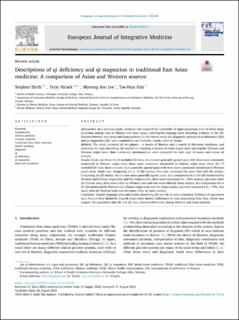| dc.contributor.author | Birch, Stephen | |
| dc.contributor.author | Alræk, Terje | |
| dc.contributor.author | Lee, Myeong Soo | |
| dc.contributor.author | Kim, Tae-Hun | |
| dc.date.accessioned | 2022-12-07T12:50:21Z | |
| dc.date.available | 2022-12-07T12:50:21Z | |
| dc.date.created | 2022-10-21T12:10:39Z | |
| dc.date.issued | 2022 | |
| dc.identifier.citation | European Journal of Integrative Medicine. 2022, 55. | en_US |
| dc.identifier.issn | 1876-3820 | |
| dc.identifier.uri | https://hdl.handle.net/11250/3036362 | |
| dc.description.abstract | Introduction
In a previous study, evidence was found of the variability of signs/symptoms (s/s) of blood stasis syndrome among texts of Chinese and Asian origin and English language texts including evidence of the differences between non-Asian and Asian patients. In the current study the diagnostic patterns of qi deficiency (QD) and qi stagnation (QS) were examined to see if similar results could be found.
Methods
The study consisted of two phases – a search of libraries and a search of electronic databases, and searching for texts describing QD and QS s/s ensuring inclusion of Asian origin texts (principally Chinese) and Western origin texts. More commonly mentioned s/s were compared for each type of source and across all sources.
Results
Study one: From the 21 included QD texts, six s/s were generally agreed upon with three more commonly mentioned in Western origin texts, three more commonly mentioned in Chinese origin texts. From the 17 included QS texts, three s/s were more generally agreed upon with three more commonly mentioned in Western origin texts. Study two: Comparing s/s in 13 QD studies, five were mentioned by more than half the studies. Comparing six QS studies, six s/s were more generally agreed upon. In a comparison of s/s for QD mentioned by Western and Chinese origin texts and the Asian studies, three were mentioned by >50% sources, one more often by Chinese texts, three more often by Western texts and one more often by Asian studies. In a comparison of s/s for QS mentioned by Western and Chinese origin texts and the Asian studies, two were mentioned by >75%, two more often by Western texts and two more often by Asian studies.
Conclusion
English language texts and studies describing QD and QS s/s were examined. Evidence of agreement on a few s/s were identified. English origin texts showed differences in texts originating from Asia, which may support the hypothesis that QD and QS may manifest differently among Western and Asian patients. | en_US |
| dc.language.iso | eng | en_US |
| dc.rights | Navngivelse 4.0 Internasjonal | * |
| dc.rights.uri | http://creativecommons.org/licenses/by/4.0/deed.no | * |
| dc.subject | Acupuncture | en_US |
| dc.subject | Chinese medicine | en_US |
| dc.subject | Oriental medicine | en_US |
| dc.subject | Traditional East Asian medicine | en_US |
| dc.subject | Herbal medicine | en_US |
| dc.subject | Diagnosis | en_US |
| dc.subject | qi | en_US |
| dc.subject | qi deficiency | en_US |
| dc.subject | qi stagnation | en_US |
| dc.subject | Signs and symptoms | en_US |
| dc.title | Descriptions of qi deficiency and qi stagnation in traditional East Asian medicine: A comparison of Asian and Western sources | en_US |
| dc.title.alternative | Descriptions of qi deficiency and qi stagnation in traditional East Asian medicine: A comparison of Asian and Western sources | en_US |
| dc.type | Peer reviewed | en_US |
| dc.type | Journal article | en_US |
| dc.description.version | publishedVersion | en_US |
| dc.source.pagenumber | 8. | en_US |
| dc.source.volume | 55 | en_US |
| dc.source.journal | European Journal of Integrative Medicine | en_US |
| dc.identifier.doi | 10.1016/j.eujim.2022.102180 | |
| dc.identifier.cristin | 2063687 | |
| dc.source.articlenumber | 102180 | en_US |
| cristin.ispublished | true | |
| cristin.fulltext | original | |
| cristin.qualitycode | 1 | |

